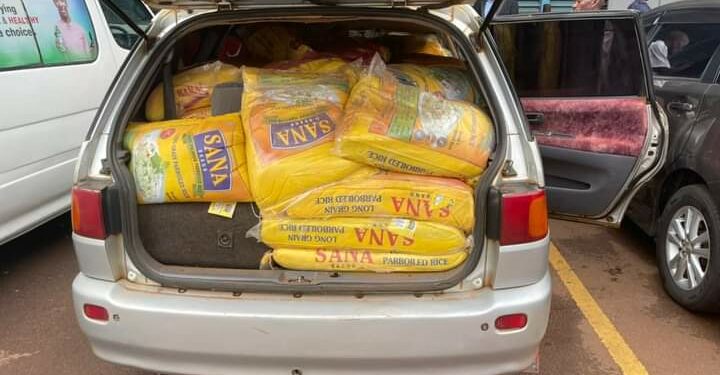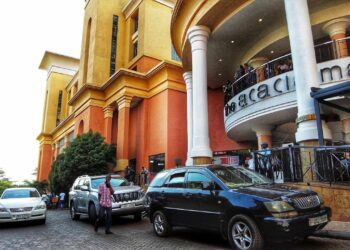In January and March 2022, Uganda Revenue Authority- URA enforcement teams reported more than 17 Metric Tons ( MT) of smuggled rice with brands such as; Sana long grain, Aisha, Baraf, Mahomood, Hilal, Salama, basmati, Pakistan and super varieties. These results were borne out of enforcement interceptions by teams in Arua, Mutukula, Busitema, Busia, Kampala, Iganga, Jinja, and Malaba. The teams noticed increased rice smuggling with taxpayers adopting several concealment tactics to get their contraband into the country while dodging tax obligations.
For example, the Busitema team made a double sweep in March when they intercepted two trucks, one coming from Tororo cement and another destined for Kampala, with concealed rice.
In the first operation, the truck was captured with rice from the forests near Busitema university loaded on top of cement bags. In the second foiling, the team caught another smuggler carrying sand as a concealer for the smuggled rice. Upon reaching Busitema checkpoint, verification from the two operations revealed 1.7 MT of Sana rice (70bagsX25kgs) from the cement truck and 3 MT of rice (120 bagsX25kgs) from the contraband concealed under sand.
Smuggled rice concealed under sand
In Busia, the team majored on intelligence focused operations, targeting consolidation centres of high risk items and recruitment of new credible informer contacts in the different suburbs. Through these, they recovered 1.8 MT of assorted Basmati Riceconcealed in sugar bags from Namaubi and Dabani.
In 2021, URA trade statistics show that Uganda imported over 11.088 million MT of goods valued at more than UGX 34 Trillion while exports stood at 3.108 million MT valued at over UGX 15 trillion. Of these trade volumes, rice volumes constituted 515,417 MT valued at over UGX 833 billion generating revenue worth over UGX 14.65 billion.
Previously, cross-border trade in rice attracted a 6% withholding tax and 18% VAT rates for Uganda’s rice imports from the EAC region member countries. However, currently, rice grown and processed within the EAC region attracts no import duty or VAT, but pays a 6% withholding tax.
The increase in smuggling therefore, is attributed to a number of factors such as seeking high prices and higher income, and high levy charges for rice imports from outside EAC.
Baraf is among the most smuggled types of rice into Uganda.
The desire to dodge taxes could also be attributed to the taxation regime for rice imported into the EAC region. Currently, this category of rice importer incurs 75% import duty, 18% VAT, must pay a withholding tax of 6% and also an infrastructure levy of 1.5%.
The brands URA intercepted are largely long grain basmati rice, imported into the region through the ports, and smuggled into Uganda through porous border points to avoid meeting the high levies. On average, the retail price for a kilogram of basmati rice ranges between UGX 6,000 to UGX 10,000. For a 25kgs of this rice variety, a trader stands to earn a maximum of UGX 500,000 from a 50kgs bag that has not paid any import duty. If you compare this to a trader dealing in ordinary brands like Pakistan and Super, a kilogram of these two varieties is sold at a retail price ranging from UGX 3,000 to UGX 3,500, giving him a profit possibility of UGX 175,000. This excessive profit in long grain rice offers a very attractive earning option that traders have sought to explore by dodging the expense of paying taxes through smuggling.
URA is committed to fighting smuggling of all forms to create a level trading ground for legitimate trade.
Do you have a story in your community or an opinion to share with us: Email us at editorial@watchdoguganda.com













